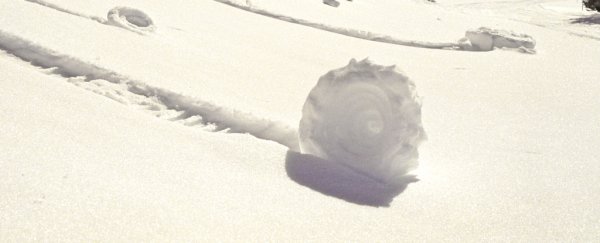Found mostly in the open prairies of North America and some remote regions of Northern Europe, snow doughnuts or snow rollers might look like icy man-made structures, but these tyre-shaped curiosities are entirely natural.
They're very rarely seen because the number of weather conditions that need to be just right for them to form - including wind, temperature, snow, ice, and moisture - is pretty astonishing.
So how do they form? It turns out you need:
- A relatively thin surface layer of wet snow on the ground
- Under that layer there needs to be a substrate the wet snow won't stick to - for example, ice or powder snow
- Wind that's strong enough to move the snow doughnut, but not too strong to blow it apart
- Or gravity to move the rollers down a hill.
Snow doughnuts start out as a thick slab of snow with a surface layer that's super-close to its melting point, Frank Barrow, a lecturer in meteorology at the Met Office in the UK, told The Telegraph in 2010.

This means the weather has to be bright and sunny enough for the surface layer to be wet and lose, but not so warm that it starts melting away.
"The top snow layer becomes a bit sticky, and you then need a fairly strong wind," said Barrow.
"The sticky layer can be peeled off the colder and more powdery snow underneath by the wind, forming a roll."
Depending on how strong the wind is, how smooth the surface of the snow is, and how far it's permitted to roll, a snow doughnut can range in size from no bigger than a tennis ball to more than half a metre tall.
It's tough for them to get this big, though, because the snow needs to have just the right amount of elasticity, and due to their hollow shape, a newly formed snow doughnut can be easily blown away and destroyed if the wind is too strong.
 (Mike Stanford)
(Mike Stanford)
Found in 2007 and photographed by avalanche supervisor Mike Stanford in the state of Washington in the US, the snow doughnut pictured above achieved a height that ordinary snow doughnuts could only dream of - a whopping 66 cm (26 inches).
"They start off with nice thick layer of snow, with the top snow just on the point of melting either because of general temperature or sunshine on the surface," explained Barrow.
"The top snow layer becomes a bit sticky, and you then need a fairly strong wind. The sticky layer can be peeled off the colder and more powdery snow underneath by the wind forming a roll … I suppose it is a natural version of making a snowman."
A version of this story was originally published in 2014.
